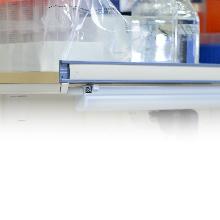Weizmann-Brazil Tumor Bank
Briefs

Weizmann cancer researchers recently received a boost to their efforts to understand cancer’s diversity, with the purchase and implementation of a major addition to the Institute’s instrumentation infrastructure: a robotically controlled freezer and storage system, capable of carefully managing the use of some 150,000 individual cancer tissue samples. The freezer, which is the size of a sprawling walk-in closet, will augment the capabilities of the Weizmann-Brazil Tumor Bank, a core facility within the Moross Integrated Cancer Center.
“Managing the complex data that emerges from the study of cancer is an extremely challenging task,” says Prof. Yardena Samuels, a member of the Department of Molecular Cell Biology who serves as Director of both the Weizmann-Brazil Tumor Bank and the EKARD Institute for Cancer Diagnosis Research at the Moross ICC. “We’ve optimized the system with original software that allows us to track every tube, histology cassette, and slide that comes in contact with a particular tumor sample, and also links this information to the chips used for tagging animal models. This makes it possible to maintain clear, fail-safe communication between different laboratory groups who make use of the same tumor sample—an essential step in promoting truly integrated cancer research.”
The Weizmann-Brazil Tumor Bank was established by a group of Brazilian philanthropists under the leadership of Mario Fleck, longtime President of the Brazil Society of Friends, who, in November, will receive the Institute’s PhD honoris causa. The Tumor Bank offers a wide range of tissue-handling and experimental technologies that have become a vital bridge to cancer-related discoveries emerging in laboratories across the Institute campus.
A patient-specific approach
Although a relatively new facility, the Weizmann-Brazil Tumor Bank has already contributed to important advances that may help more cancer patients get the personalized treatment they need.
Recent research conducted by Prof. Samuels and her colleagues has generated new hope for an effective, patient-specific approach to the clinical treatment of melanoma. She has identified surface peptides (called “neo-antigens”) that are highly specific to melanoma cells, making it possible to selectively activate the immune system to combat them. In laboratory experiments, the Samuels team was able to identify neo-antigens—and the immune system T cells primed to respond to them—with enormous efficiency, successfully killing 90% of melanoma cells targeted in cell culture, and in mice, while leaving healthy cells untouched.
This new method sheds light on a possible pathway toward personalized cancer immunotherapy capable of matching the treatment to the specific type of tumor, as well as to a specific stage of tumor development. Moreover, the neo-antigen profiles that Prof. Samuels discovered could potentially aid in the design of drug compounds capable of stimulating T cells to destroy not just an individual patient’s primary tumor, but metastasized, secondary malignancies as well.
Targeting lung cancer
Another recent project that utilized Tumor Bank technology contributed to a discovery that could help solve a significant problem in the treatment of lung cancer: the fact that many lung cancer patients develop resistance, over time, to a category of cancer immunotherapy drugs called tyrosine kinase inhibitors, or TKIs.
TKIs fight cancer by blocking the action of enzymes—called tyrosine kinases—that are abnormally active in some types of cancer cells, and contribute to the growth of certain types of lung tumors. However, the benefit of such treatment can be fleeting; after less than a year, the cancer can recur.
A recent investigation led by Prof. Yosef Yarden of the Department of Biological Regulation demonstrated that, by administering tyrosine kinase inhibitors together with other types of immunotherapy medication, it is possible to forestall the emergence of TKI drug resistance. The study was carried out under the supervision of Dr. Donatella Romaniello, a postdoctoral researcher in the Yarden lab.
To reach these findings, the scientists made use of something available at the Weizmann-Brazil Tumor Bank: a patient-derived xenograft (PDX) model of human lung cancer. In PDX technology, human tumor samples are implanted into specially engineered mice. This technique allows scientists to observe the tumor in a living system, and achieve findings that might not have been discovered using isolated cancer cells and tissues.
With the PDX studies, Prof. Yarden and his team identified a drug combination that blocks the emergence of TKI resistance in lung cancer, thereby reducing tumor regrowth. The scientists plan to test this new drug protocol in human clinical trials. If successful, the team’s work could lead to a new standard of care for this type of lung cancer.
The Yarden lab’s achievement also has implications for improving future treatments for HER2-positive breast cancer, a particularly aggressive and hard-to-treat tumor type. This is because one of the drugs used in combination in the lung cancer study targets the genetic mutation associated with HER2. Prof. Yarden and his team plan to explore this additional avenue of cancer research in the future.
Propelling research forward
The PDX models available through the Weizmann-Brazil Tumor Bank are propelling cancer science forward, but developing such models is a long and expensive process. To accelerate the further integration of this technology into the day-to-day work of Weizmann scientists, the Tumor Bank is initiating a collaboration with EuroPDX—a consortium of institutions who exchange PDX models in order to avoid duplication, as well as speed the pace of research discovery.
Under the direction of Prof. Sima Lev of the Department of Molecular Cell Biology, the Tumor Bank is working on gaining access to particular PDX models—particularly models that bear a hard-to-treat tumor type called “triple negative” breast cancer. Such models will form the basis of new studies by Weizmann Institute scientists, as they search for more effective, and more personalized treatments.








